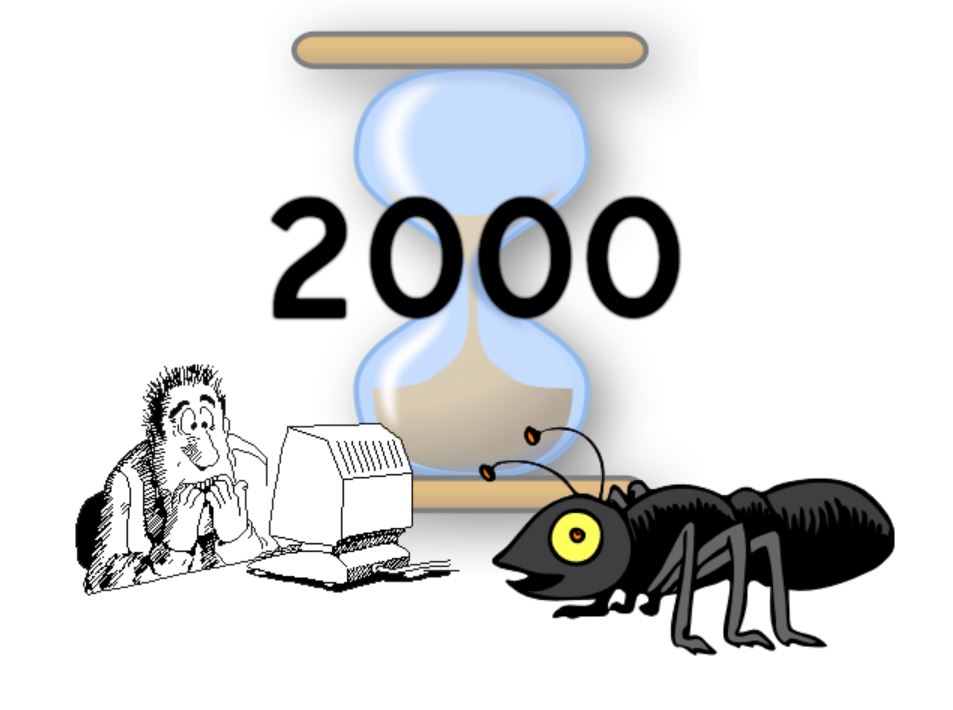On New Year’s eve, December 31, 1999, the world came to a standstill. Millions of people around the globe sat waiting for the long anticipated transition into a new millennium. The event they were anticipating was called Y2K, or “Year 2000.” This year was predicted to be a harbinger of an apocalypse of sorts. A minute into January 1, 2000… fear of a worldwide power loss… major economies would crash… jails would spring open to let out vicious criminals… money in banks would be spewing out of ATM machines… countries would grind to a halt as people would not understand what is happening… The end of the world would have come… No one would be sure what would happen next, but everyone would quickly learn that the very devices that made their lives easy would turn on them as those devices failed to process the shift into the new millennium.1
But then, when the end of the year 1999 did come, and all the time zones jumped into the new millennium, almost nothing of the sort happened. Planes did not fall out of the sky, jails did not let criminals free, and the world was certainly no closer to its end. What was it that left a planet of about six billion human inhabitants panic-stricken?2 The villain in this case was a bug programmed at the very roots of computers. Computer storage space was available at a premium at the dawn of the computer age in the 1960s. To economize in this aspect, programmers displayed dates in a two-digit format rather than the conventional four digit(YYYY) format. The programmers failed to factor in the imminent jump to a new millennium, or even a new century. The problem was quite simply that computers would be unable to process any year after the year 1999. The systems would be set back by a century. As the realization dawned upon the commercial sector in the early 1980s, there wasn’t much panic. However, as more specific problems began sprouting, the problem was recognized. This problem, famously dubbed as the Y2K Crisis or the Millennium Bug was the reason for the worldwide panic in the late 1990s.3

The Y2K problem began with the development of commercial computing. In 1957, Rear Admiral Grace Murray Hopper invented a programming language called FLOW-MATIC, the first to be coded in English in order to make computers easier for businesses to use. FLOW-MATIC formed the basis for the programming language COBOL, the acronym for “common business-oriented language.”4 The most commonly used data storage media was the eighty-column punch card. Due to the limited storage possible on these punch cards, COBOL used only 6 digits for dates. For example, January 4, 1987 would be stored as 010487 in the MMDDYY format. This shortcut seemed to be revolutionary at that time in terms of economizing on storage space, but little did they know that it would be the reason for a worldwide panic-induced frenzied-spending to correct this “bug.”
In a testimony by Alan Greenspan, ex-chairman of the Federal Reserve before the Senate Banking Committee, he said,
“I’m one of the culprits who created this problem. I used to write those programs back in the 1960s and 1970s, and was proud of the fact that I was able to squeeze a few elements of space out of my program by not having to put a 19 before the year. Back then, it was very important. We used to spend a lot of time running through various mathematical exercises before we started to write our programs so that they could be very clearly delimited with respect to space and the use of capacity. It never entered our minds that those programs would have lasted for more than a few years. As a consequence, they are very poorly documented. If I were to go back and look at some of the programs I wrote 30 years ago, I would have one terribly difficult time working my way through step-by-step.”5
After the development of COBOL in 1957, no one really bothered to think ahead to chart out possible problems. However, one of COBOL’s developers, Robert Bemer, along with a group of computer scientists, picked up this issue and attempted to warn against the use of the two digit-style and rather argued for the four-digit style for years. However, the hunger for businesses to increase their profits made the big businesses overlook this warning. To most businesses and governments, the year 2000 seemed much too far away to worry about. They thought they would cross that bridge when they get there, but little did they know that this very act of ignorance would create a bridge so large that crossing it would be impossible for many. Bemer again published warnings in the years 1971 and 1979, but they were ignored yet again. Another warning was issued by Peter de Jager, a Canadian computer engineer, who published an article titled “Doomsday 2000” that predicted an economic recession in the year 2000. However, by then, the warning signs were already visible for the world to see.6 Robert Bemer and Peter de Jager weren’t really the first to notice the problem. Programmers knew what their earlier compromise to economize now meant, and they began laying their bets on the hope that the erroneous code would be scrapped by the year 2000. However, the program was integrated into almost every essential sector you could think of. As the year 2000 got closer, the Y2K bug did seem to be very real.

Although realization of this potential problem hadn’t yet dawned upon much of humanity, the spending had already begun to correct the issue in time. One of the earliest high spenders was the New York Stock Exchange, having reportedly spent a figure close to $29 million and recruited about a 100 programmers to fix the bug.7 The leading nation in responding to the Y2K crisis was the United States. However, planning only began in the late 1990’s when it had become a subject of serious discussion. At last, the bridge was in sight and the governments and companies around the world began to plan their voyage across the millennium. The biggest leap was made by the United States, when President Clinton created the President’s Council on Year 2000 Conversion on February 4, 1998 by executive order 13073. This council was formed with the intention of addressing the broader picture regarding the impact of the year 2000 conversion in the United States and around the world. The council worked closely with small and large businesses alike to encourage greater Y2K preparation. Seeing these efforts, the United Kingdom and Australia followed suit by adopting similar programs. The UK formed two agencies, Action 2000 and Taskforce 2000, which were granted funding of $544 million, whereas the Australian Commonwealth’s spending was estimated to be around $12 billion.8 The United States alone spent $100 billion, including $8.5 billion by the federal government, according to the U.S. Department of Commerce. The worldwide bill was estimated at between $500 billion and $600 billion.9 Many people argued against spending on a such a large scale when the prognosis of the issue was still debatable. However, the Governor of Georgia, Roy Barnes, aptly said, “I don’t think you can overprepare for a disaster that could have happened. I’d rather err on the side of caution rather than on the side of recklessness.”10

As countries around the world were spending large amounts on the problem, panic began to grow as realization of the possible dire prognosis set in upon the people. As the year 2000 approached, panic was hitting a fever pitch. People began to stockpile on essential supplies, some governments couldn’t meet their deadline for Y2K compliances, and people all around the world were preparing for the worst. At the stroke of midnight, on New Year’s eve 1999 the world moved into the new millennium without skipping a beat. No system failures occurred except for a few minor issues that were quite comical. A 105 year old man was directed to kindergarten as his age showed up as five on the records. Some newborn children were registered as born on January 1, 1900.11 Defense Minister John Hamre said, “For a short period of time we were not able to process the information that the satellites were sending to us, but we’re operational now.” This was a rare case of admittance from the Pentagon as the ground station lost contact with a satellite. Another comical issue occurred when a video rental customer was sent a bill of around $91,000 for apparently having missed payment for the past 100 years.12 Another problem that arose, which demonstrated that the Y2K bug was truly global, occurred in France. Meteo France reported that the Y2K bug was responsible for an issue in the system on its website. Weather forecast for January 1, 2000 showed the date on its page as 01/01/19100.13 The world breathed a sigh of relief as the problems that showed up on January 1, 2000 were only minor and required small fixes. It looked as if the disaster that was feared had been averted.
Success very rarely comes without critics, and in this case the critics were angered over the amount spent correcting the Y2K bug. Letters flooded into the rooms of editors of business periodicals accusing the IT professionals of having inflated the danger of the issue to scare businesses into spending more than was necessary. However, they were missing the bigger picture here. The Y2K crisis called for the most effective joint response effort from the private and public sectors that the United States had ever seen, as well as extensive international cooperation. In addition to avoiding disaster, the preventative effort was highly beneficial to businesses as they learned how to conduct contingency planning for IT malfunctions. Others, especially small businesses, learned how to use computers effectively for the first time.14
In the aftermath of this conundrum, critics began to call the whole crisis a hoax. Some even went as far as to calling it a conspiracy theory. In reality, it was the consistent heroic efforts of computer scientists, companies, and governments all over the world that helped us cross the finish line. The Y2K Bug, was it really all just a hoax? No, it was the greatest success story of the generation.15
- Roger Smith, “Y2K ‘Crisis,’” in Salem Press Encyclopedia (Salem Press, 2021). ↵
- “World Population by Year – Worldometer,” accessed April 14, 2021, https://www.worldometers.info/world-population/world-population-by-year/. ↵
- John Quiggin, “The Y2K Scare: Causes, Costs and Cures,” Australian Journal of Public Administration 64, no. 3 (September 2005): 47, https://doi.org/10.1111/j.1467-8500.2005.00451.x. ↵
- Roger Smith, “Y2K ‘Crisis,’” in Salem Press Encyclopedia (Salem Press, 2021). ↵
- Professor Martyn Thomas, “What Really Happened in Y2K?,” n.d., 2. ↵
- Roger Smith, “Y2K ‘Crisis,’” in Salem Press Encyclopedia (Salem Press, 2021). ↵
- “Y2K: The Strange, True History of How Canada Prepared for an Apocalypse That Never Happened, but Changed Us All,” accessed April 15, 2021, https://www.theglobeandmail.com/canada/article-y2k-20th-anniversary-how-canada-prepared/. ↵
- John Quiggin, “The Y2K Scare: Causes, Costs and Cures,” Australian Journal of Public Administration 64, no. 3 (September 2005): 46–55, https://doi.org/10.1111/j.1467-8500.2005.00451.x. ↵
- Roger Smith, “Y2K ‘Crisis,’” in Salem Press Encyclopedia (Salem Press, 2021). ↵
- “CNN – Preparation Pays off; World Reports Only Tiny Y2K Glitches – January 1, 2000,” December 7, 2004. ↵
- Roger Smith, “Y2K ‘Crisis,’” in Salem Press Encyclopedia (Salem Press, 2021). ↵
- “BBC NEWS | Americas | US Satellites Safe after Y2K Glitch,” accessed March 30, 2021, http://news.bbc.co.uk/2/hi/americas/589836.stm. ↵
- “BBC NEWS | Science/Nature | Minor Bug Problems Arise,” accessed March 30, 2021, http://news.bbc.co.uk/2/hi/science/nature/586620.stm. ↵
- Roger Smith, “Y2K ‘Crisis,’” in Salem Press Encyclopedia (Salem Press, 2021). ↵
- “Y2k Was a Huge Success Story,” Sunday Star-Times (Sunday Star-Times, October 25, 2020). ↵



30 comments
Farzana Shaik
A very well written article. Kee up the good work!! The first time I heard about Y2K was in late 1998 when I was getting married to your phuppa, and he was working on an assignment in mainframes and COBOL to fix the problem. It refreshed my memory reading your article. Good luck with your future work!!
Danielle Slaughter
Hey, Mohammed.
I guess I should count myself grateful I wasn’t cognizant for this hysteria, ha! My mother told me that she stocked up on water and canned foods, though, just in case we had to make it through some worldwide network failure for a while. Obviously, growing up, it never registered as anything to be concerned about — the clocks would simply do what they were supposed to do, count!
Grace Frey
I would like to think that the most notable thing to happen in 2000 was my birth. Just kidding! I loved reading this article, because it provided great information about something that happened over 21 years ago. I knew about the fear of the new millennium and the chaos that it would allegedly bring, but I wasn’t aware about the term Y2K bug and the lessons that it would serve for things to come.
Valeria Varela
The first time I’ve ever read about the Y2K bug and it’s actually kind of insane how much chaos it brought worldwide especially when at the end it was not super impactful as everyone believed it would be. The amount of money that was spent though what is extreme. This was a very good article to read end it was slightly funny of how everything turned out.
Faith Chapman
I’m glad that I read this article, as I had heard about the Y2K bug before and that people thought the 2000 would be the year of the end of the world, but I didn’t understand why; I always underestimate how much technology existed in the 1980-1990s and how much computers were essential to everyday life—in fact, most baking systems to this day still use COBOL—so if the computers did just shut down or crash, the world indeed would have ended, though in a less literal sense.
Madeline Chandler
In all honesty, I have never heard of Y2K bug. Also, with the chaos surrounding the transition of 1999 to 2000…. I guess because that was before my time. But the world including businesses, everyday people, and every device in the world. This article really elaborated on the stress and tension around the change of the millennium. Thank you for writing about a subject I had no knowledge on prior.
Madeline Emke
This was the first time I had heard of the Y2K Bug. I also never realized there was such a big fear surrounding the transition from 1999 into 2000. The article provided a detailed journey through the fear and chaos surrounding the Y2K bug without delving into a boggy description. Overall, very good quality article and very persuasive writing.
Aaron Sandoval
This article was a fun read, the author did a good job of explaining and detailing the Y2K bug and the impact it had on the world. It is certainly fascinating that a minor bug could wreak such havoc across the world, and in the end, it really turned out to be not nearly as big of a deal as people thought. While not having lived through the Y2K panic, I have heard of it from family and in hindsight, it all seems very comedic despite the mass hysteria at the time.
Hoa Vo
This is the first time I heard about the y2k bug and its effect on the computer software system. It is a very informative article that a person not majoring in computer science like me still has a general understanding of the y2k bug’s influence. The bug was realized and researched around the 20th century, so I wonder how the research of this bug worked these days.
Santhi Rajasri Sadhanala
Hani had indeed done an extensive research to reveal the startling facts of the millennium crises.The paper has an intensive expression employed with a subtle style and language.